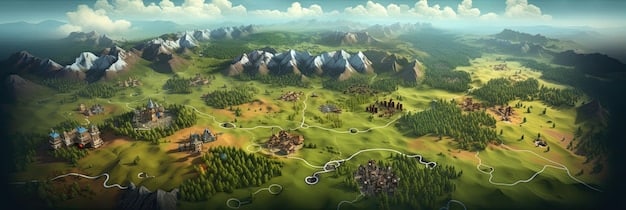The Evolution of Open-World Games: 2025 Predictions

The Evolution of Open-World Games: A Retrospective and Future Predictions Based on 2025 Releases explores how the open-world genre has transformed gaming over the years and speculates on key advancements expected in upcoming 2025 releases, focusing on enhanced player agency and immersive experiences.
The evolution of open-world games: a retrospective and future predictions based on 2025 releases showcases a remarkable journey from simple explorations to deeply immersive experiences. As technology advances, what can we expect from the genre’s future?
A Brief History of Open-World Games
Open-world games have redefined player freedom and exploration. This section examines their origins and the milestones that shaped the genre.
Early Pioneers: The Foundations of Freedom
The earliest examples of open-world design laid the groundwork for future innovations. Games like “Elite” and “The Legend of Zelda” presented players with expansive worlds to explore.
These pioneering titles emphasized non-linear gameplay, allowing players to chart their own course. This was a departure from the restrictive, level-based structures that defined earlier gaming experiences.
- Elite (1984): A space trading and combat simulator, “Elite” offered a vast, procedurally generated galaxy to explore, setting a precedent for scale and freedom.
- The Legend of Zelda (1986): This Nintendo classic introduced a sprawling overworld filled with secrets, dungeons, and characters, encouraging exploration and discovery.
- Ultima VI: The False Prophet (1990): Known for its interactive world and moral choices, offering players unparalleled freedom within rich narrative context.
These early titles, while limited by technology, established the core principles of open-world design. They demonstrated the appeal of freedom and exploration in gaming.
The 3D Revolution: Expanding Horizons
The advent of 3D graphics unleashed new possibilities for open-world design. Games like “The Elder Scrolls: Arena” and “Grand Theft Auto III” capitalized on this technology to create more immersive and detailed worlds.
These titles pushed the boundaries of what was possible in open-world games. They combined expansive environments with engaging gameplay and compelling narratives.

The transition to 3D allowed developers to create more realistic and immersive worlds. Players could now explore environments with a greater sense of depth and scale.
In conclusion, the early pioneers and the 3D revolution laid a strong foundation for modern open-world games, setting the stage for the genre’s future growth and innovation.
Key Innovations in Open-World Design
Several innovations have significantly impacted open-world design. This section explores the critical features that define contemporary open-world games.
Emergent Gameplay and Player Agency
Emergent gameplay refers to game mechanics that allow for unexpected and dynamic interactions. Player agency is the extent to which players can influence the game world and its events.
These features enhance replayability and create unique, personalized experiences for each player. They transform open-world games from static environments into dynamic ecosystems.
Emergent gameplay often arises from the interaction of various game systems. For example, the weather, AI behavior, and physics can combine to create unpredictable moments.
Dynamic Worlds and Environmental Storytelling
Dynamic worlds respond to player actions and change over time. Environmental storytelling uses visual cues and environmental details to convey narrative information.
These features add depth and immersion to open-world environments. They make the game world feel alive and interconnected.
- Environmental Detail: The meticulous placement of objects, structures, and environmental features enhances the game’s atmosphere and provides clues about its history and inhabitants.
- reactive environments: Dynamic weather systems, day-night cycles, and seasonal changes affect gameplay and create a sense of realism.
- AI Interactions: Non-player characters (NPCs) with routines, behaviors, and interactions that contribute to world’s sense of life and immersion.
Dynamic worlds and environmental storytelling enrich the gaming experience, fostering a sense of discovery and making the game world feel authentic and engaging.
Narrative Depth and Compelling Characters
Strong narratives and well-developed characters are essential for drawing players into the game world. They provide context and motivation for player actions, making the experience more meaningful.
Open-world games often feature branching storylines and multiple endings, allowing players to shape the narrative through their choices. This level of interactivity enhances player engagement and investment.
Compelling characters are more than just quest-givers. They have their own backstories, motivations, and personalities, making them feel like real people living in the game world.
In conclusion, innovations like emergent gameplay, dynamic worlds, and narrative depth have transformed open-world games into immersive and engaging experiences, setting the stage for future advancements.
The Current State of Open-World Games (2024)
As of 2024, open-world games have reached a new level of complexity and sophistication. This section provides an overview of the current state of the genre.
Technological Advancements: Driving Innovation
Technological advancements have been a major driver of innovation in open-world games. Improved graphics, physics engines, and AI have enabled developers to create more realistic and immersive environments.
Real-time ray tracing, advanced lighting techniques, and high-resolution textures contribute to visual fidelity, creating stunning and believable worlds.
- Improved Graphics: Enhanced visual fidelity creates immersive and stunning environments.
- Advanced Physics: Realistic physics engines enable dynamic interactions and emergent gameplay.
- Sophisticated AI: NPCs with complex behaviors and routines enhance the sense of realism.
These advancements have pushed the boundaries of what is possible in open-world design, allowing for richer and more engaging experiences.

Popular Titles and Defining Trends
Several popular titles have defined the current state of open-world games. These games exemplify the trends and innovations that are shaping the genre.
Games like “Elden Ring,” “Cyberpunk 2077,” and “The Legend of Zelda: Breath of the Wild” showcase different approaches to open-world design, each with its own strengths and weaknesses.
“Elden Ring” emphasizes exploration and challenging combat. “Cyberpunk 2077” focuses on narrative depth and world-building. “Breath of the Wild” prioritizes player freedom and emergent gameplay.
These games exemplify the diverse range of experiences possible in modern open-world games, setting the bar for future releases.
In summary, the current state of open-world games is characterized by technological advancements, popular titles, and diverse trends, creating a vibrant and dynamic landscape for players to explore.
Anticipated Features in 2025 Open-World Games
Looking ahead to 2025, several anticipated features promise to redefine the open-world experience. This section explores the key advancements expected in upcoming releases.
Enhanced AI and NPC Behavior
One of the most promising advancements is the improvement of AI and NPC behavior. Developers are working on creating NPCs that are more realistic, responsive, and engaging.
Advanced AI systems will allow NPCs to react dynamically to player actions, making them feel like real people living in the game world. This will enhance immersion and create more meaningful interactions.
NPCs may have their own routines, goals, and motivations, making them feel more alive and authentic. This will add depth and complexity to the game world, and enhance the overall experience.
Enhanced AI and NPC behavior promises to make open-world environments more dynamic and engaging, blurring the line between virtual and reality.
Seamless Integration of Multiplayer Elements
Another key trend is the seamless integration of multiplayer elements into open-world games. This will allow players to share the experience with friends and strangers, creating new opportunities for cooperation and competition.
Multiplayer elements can enhance replayability and add a social dimension to open-world games. Players can team up to complete quests, explore the world, or simply hang out and socialize.
Seamless integration means that players can transition smoothly between single-player and multiplayer modes, without disruptive loading screens or menu navigation.
Seamless integration of multiplayer elements will enrich the social experience in open-world games, fostering a sense of community and expanding the possibilities for player interaction.
In conclusion, anticipated features like enhanced AI and seamless multiplayer integration promise to elevate the open-world experience, making games more immersive, engaging, and socially connected.
Predictions Based on 2025 Releases
Based on the announced and anticipated releases of 2025, we can make several predictions about the future of open-world games. This section explores these predictions.
Greater Focus on Player Choice and Consequence
One prediction is that there will be a greater focus on player choice and consequence in upcoming open-world games. Developers are prioritizing player agency, allowing players to shape the game world and its events through their actions.
Meaningful choices will have a lasting impact on the game world, affecting relationships, storylines, and the overall narrative. This will enhance replayability and create personalized experiences for each player.
Players will be faced with difficult decisions that have moral implications, forcing them to consider the consequences of their actions. This will add depth and complexity to the gameplay experience.
A greater emphasis on player choice and consequence promises to make open-world games more engaging and meaningful, giving players a greater sense of ownership over their experiences.
The Rise of Procedurally Generated Content
Another prediction is the increased use of procedurally generated content in open-world games. This will allow developers to create vast and diverse environments with limited resources.
Procedurally generated content can create unique and unexpected landscapes, filling game worlds with diverse plants, animals, and geological features. The results are more varied and immersive environments.
While procedural generation has its limitations, it can provide the game world with details for players to explore which is particularly useful in large open-world games.
In short, while procedural generation has limitations, the benefits of helping fill out details for large open-world games make it an invaluable tool for game developers in this category.
Integration of AR and VR Technologies
The integration of augmented reality (AR) and virtual reality (VR) technologies may be something open-world games consider. These technologies would completely revolutionize the way gamers experience virtual worlds.
AR could overlay game elements onto the real world, creating unique and immersive experiences. Imagine exploring a virtual world that is seamlessly integrated with your actual surroundings. As these capabilities get refined, they are likely to be adopted by game developers in this category. Even further, as the technology becomes more affordable, adoption rates grow wider.
The integration of AR and VR would bridge the gap between the virtual and real worlds. A move towards this direction would add another layer of immersion.
These advances provide enhanced immersion and greater player engagement in the games played for those willing to adopt the technology.
In conclusion, the future of open-world games will likely be shaped by a greater focus on player choice, procedurally generated content, and the integration of AR and VR technologies, creating more immersive and engaging experiences for players.
E-E-A-T and the Future of Game Reviews
The principles of Experience, Expertise, Authoritativeness, and Trustworthiness (E-E-A-T) play a crucial role in the future of game reviews. This section examines how these principles will influence the credibility and value of game content.
Demonstrating Experience in Game Reviews
Experience refers to first-hand knowledge and practical involvement with the game being reviewed. Reviewers should demonstrate their experience by providing specific examples and insights based on their own playthrough.
Readers want to know that the reviewer has actually played the game and understands its mechanics, storyline, and overall experience. Generic reviews that lack specific details are less valuable and trustworthy.
Reviewers can demonstrate experience by detailing their gameplay strategies, challenges faced, and moments of discovery. Sharing personal anecdotes and insights adds credibility and authenticity to the review.
Showcasing experience in game reviews enhances their value and credibility, providing readers with a reliable and trustworthy assessment of the game.
Establishing Expertise and Authority
Expertise refers to the reviewer’s knowledge and skills in the subject matter being reviewed. Authority is the recognition and respect earned from peers and readers in the gaming community.
Reviewers can establish expertise by demonstrating their understanding of game design principles, industry trends, and technical aspects. Providing insightful analysis and informed opinions adds weight to the review.
Building authority requires consistent, high-quality content and engagement with the gaming community. Participating in discussions, attending industry events, and collaborating with other experts can enhance a reviewer’s reputation.
Establishing expertise and authority is essential for creating trustworthy and valuable game reviews. Readers are more likely to trust reviews from knowledgeable and respected sources.
In conclusion, adhering to the principles of E-E-A-T will be essential for the future of game reviews. Demonstrating experience, expertise, and authority will enhance the credibility and value of game content, ensuring that readers receive reliable and trustworthy assessments.
| Key Point | Brief Description |
|---|---|
| 🎮 Origins of Open Worlds | Early games like “Elite” set foundations with expansive, explorable environments. |
| ✨ Key Innovations | Emergent gameplay and narrative depth enhance player experience. |
| 🤖 2025 Predictions | Enhanced AI and seamless multiplayer integration are expected. |
| 👓 E-E-A-T Importance | Experience, Expertise, Authoritativeness, and Trustworthiness are vital for credible reviews. |
Frequently Asked Questions
▼
An open-world game is characterized by its non-linear gameplay, allowing players to freely explore a virtual world and complete objectives in any order. This freedom distinguishes it from level-based games.
▼
Early pioneers include “Elite” (1984) with its vast galaxy, “The Legend of Zelda” (1986) offering an explorable overworld, and “Ultima VI” (1990) known for interactivity.
▼
Advancements in 3D graphics, real-time ray tracing, and high-resolution textures create visually stunning and immersive environments, enabling players to explore with greater realism and depth.
▼
Anticipated features include enhanced AI for more realistic NPCs, seamless integration of multiplayer for shared experiences, and more focus on player choices impacting the game world.
▼
Experience, expertise, authoritativeness, and trustworthiness (E-E-A-T) build credibility. They ensure the reviews are reliable, insightful, and provide value for readers seeking trustworthy assessments.
Conclusion
The evolution of open-world games showcases a continuous journey toward greater immersion, player freedom, and technological innovation. As we look to 2025, the integration of enhanced AI, procedural content, and AR/VR technologies promises to redefine the open-world experience, creating even more dynamic and engaging virtual worlds for players to explore.





